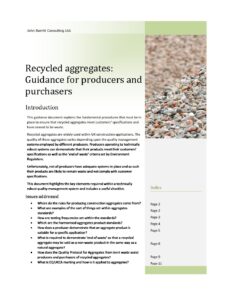Recycled aggregates Guidance v2
Recycled aggregates: Guidance for producers and purchasers
Following many questions and discussions over the first two years of this consultancy a downloadable guidance document has been produced to explain the fundamental procedures that must be in place to ensure that recycled aggregates meet customer’s specifications and have ceased to be waste.
Recycled aggregates are widely used within UK construction applications. The quality of these aggregates varies depending upon the quality management systems employed by different producers. Producers operating to technically robust systems can demonstrate that their products meet their customers’ specifications as well as the ‘end of waste’ criteria set by Environment Regulators.
Unfortunately, not all producers have adequate systems in place and as such their products are likely to remain waste and not comply with customer specifications.
The guidance document highlights the key elements required within a technically robust quality management system and includes a useful checklist.
Issues addressed within the guidance are:
- Where do the rules for producing construction aggregates come from?
- What are examples of the sort of things set within aggregates standards?
- How are testing frequencies set within the standards?
- Which are the harmonised aggregates product standards?
- How does a producer demonstrate that an aggregate product is suitable for a specific application?
- What is required to demonstrate ‘end of waste’ so that a recycled aggregate may be sold as a non-waste product in the same way as a natural aggregate?
- How does the Quality Protocol for Aggregates from inert waste assist producers and purchasers of recycled aggregates?
- What is CE marking and how is it applied to aggregates?

